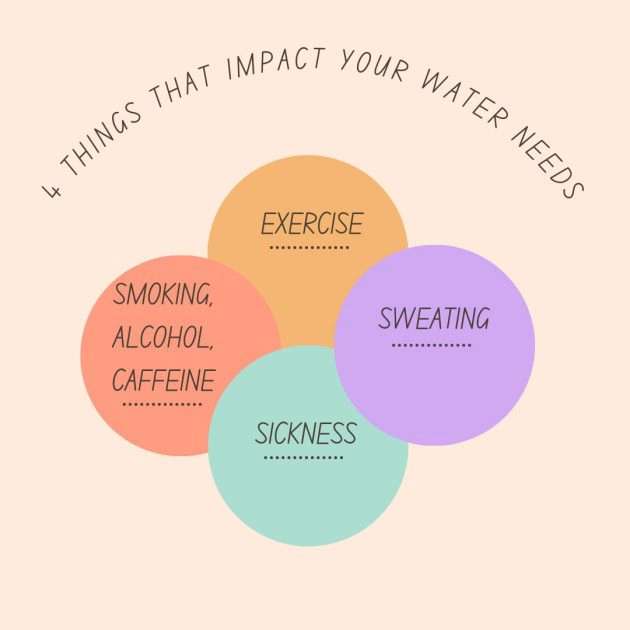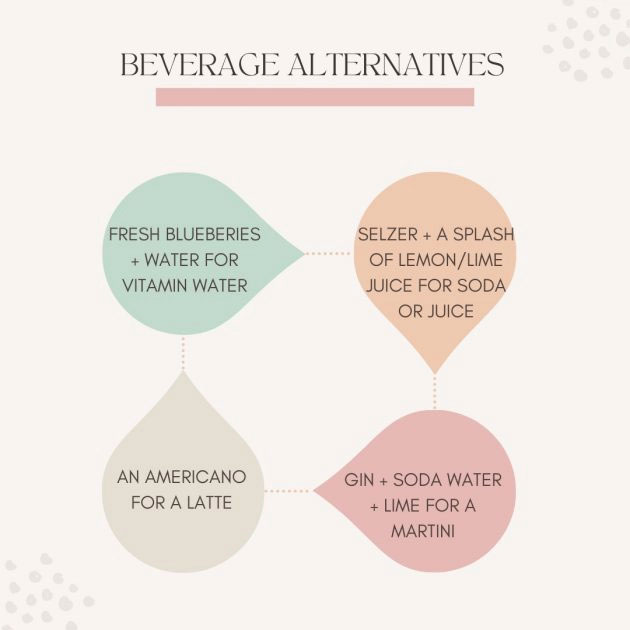INTRODUCTION
Your body is made up of approximately 60% water. Your body uses and loses it through most of its work – detoxification, lubrication, temperature regulation, nutrient absorption – so you need to regularly replenish your stores.
You can literally see a lot of your hydration losses through sweating and elimination daily. We’ve all heard the advice to drink 8 glasses of water a day but is 8 glasses right for you? And how big should your glass be? Yikes, there’s so much to think about! Let’s break this down and find out how much you really need to drink every day and what impacts your water needs.
WHAT ARE MY WATER NEEDS?

While there’s no magic number for daily hydration, you can determine the water range that’s better for you. Here’s a little equation you can use: Weight (lbs) /2 = oz/day. So if you weigh 150#, that comes out to 75 oz/day or about 9 8-ounce glasses a day.
SIGNS YOU’RE DEHYDRATED
But hey life happens and we don’t always drink the optimal amount every day. And the signs of dehydration aren’t always obvious — in fact, they can be downright sneaky! Things like fatigue, hunger, or cravings can be a sign you need to hydrate, so drink a glass of water and wait 5 minutes — was your body using thirst to get your attention?
Got dry skin, dark yellow urine, headaches, or even constipation? All these are signs that your body needs some more water to drink.
THINGS THAT CAN IMPACT YOUR WATER NEEDS

- Exercise: If you exercise for more than 20 minutes, add 10-15 ounces to your daily intake.
- Excessive sweating: Any time you sweat so much you have to change your clothes, add 5-10 ounces to your routine. If you take a sauna or just live in a place that feels like one, add 10-20 ounces daily.
- Sickness: Fighting a cold or trying to heal? Add 20 ounces.
- Smoking, alcohol, and excessive caffeine can all be dehydrating so add 10 ounces on those days.
DOES IT MATTER WHERE MY WATER COMES FROM?
Short answer — YES! While all beverages and water-based fruits and veggies add to your fluid intake, some choices are better than others. The best: watery options like tap water, bottled water, filtered water, and unsweetened herbal teas because they don’t have any added sugars, additives, colorings, caffeine, or alcohol. Try to get at least half your water intake from these choices.
DO CAFFEINATED BEVERAGES OR SODAS COUNT

If most of your beverages are bright blue, high octane, or ordered at happy hour, you may want to consider making a few swaps. Some better alternatives:
- Seltzer with a splash of lemon or lime juice is a great swap for soda or juice.
- Gin and soda water plus lime is a better choice than a gin martini with an olive.
- Try an Americano rather than your usual latte.
- Add blueberries to your water instead of drinking the blue-colored vitamin variety.
WHAT ABOUT ALKALINE-FORMING WATERS
All water is “alkaline-forming” in your body. Sadly, this is a marketing ploy you need to pay attention to — you’re paying extra for it! While some waters may naturally have a more alkaline pH, others don’t.
Some of these beverages may even be made “more alkaline” by the addition of certain minerals and this could be a health issue for some of us, so make sure to discuss this with your healthcare practitioner if this is your primary source.
HOW DO I DRINK MORE WATER?

- Don’t like plain old water? Try adding fresh-cut cucumber, orange, or lemon slices to the water for a hint of flavor.
- Add a splash of pure pomegranate juice or cherry juice to your water for more flavor but no added sugar or calories.
- Caffeine-based beverages like coffee and tea are ok as long as you limit your intake to what is better for your body’s sleep, digestion, anxiety levels, etc. Remember: Coffee and tea drinks may replace water with other beverages and ingredients. They don’t contribute as effectively in helping you meet your needs.
- Use your phone to set a reminder every hour to drink a few sips.
- Keep a stainless steel or glass water bottle near you at all times for easy access.
- If you just can’t seem to drink water during the day, try to get it in before you start your day and soon after you end it. But try to limit fluid intake 2 hours before going to bed to reduce sleep interruptions.
- Set your personal water goal and try to increase your fluid intake by 2-4 oz/day, increasing each week until you reach your goal.
- If you drink a lot of soda (regular or diet) try to wean down slowly. Substitute one soda each week with the sparkling variety plus a splash of pure pomegranate, cherry, or other pure juice.
- For juice drinkers, dilute with water and cut back by 2 oz each week until you transition to water.
- If you drink alcohol, the general rule is a max of 1 drink a day (7 drinks/week) for women and up to 2 drinks/day (14 drinks/week) for men. However, alcohol is a personal decision you should discuss with your healthcare practitioner as it may impact your overall health goals.
CONCLUSION
Water is vital for your body to function properly — without it, you die! An estimated 75% of Americans are chronically dehydrated and drink only 2.5 cups on an average day. Feeling tired, hungry, and constipated is not living your best life!
But there is a better way! Now that you know all the things that can impact your water needs and what you can do to add more of this vital liquid to your life, you don’t have to be that cranky, tired person anymore. Praise be to he!
Your drinking habits are just one small habit that can potentially have a huge impact on your overall health. If you need an eating habits makeover, please ask me about my Eating Habits Evaluation and I’ll be more than happy to send it over to you.
***Disclaimer: This post is for informational purposes only and should not be construed as medical advice***

